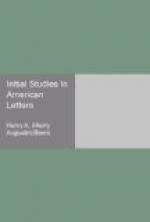He cared very little about the intellectual movement of the age. The transcendental ideas of Emerson passed over his head and left him undisturbed. For politics he had that gentlemanly distaste which the cultivated class in America had already begun to entertain. In 1842 he printed a small volume of Poems on Slavery, which drew commendation from his friend Sumner, but had nothing of the fervor of Whittier’s or Lowell’s utterances on the same subject. It is interesting to compare his journals with Hawthorne’s American Note Books, and to observe in what very different ways the two writers made prey of their daily experiences for literary material. A favorite haunt of Longfellow’s was the bridge between Boston and Cambridgeport, the same which he put into verse in his poem, The Bridge. “I always stop on the bridge,” he writes in his journal; “tide waters are beautiful. From the ocean up into the land they go, like messengers, to ask why the tribute has not been paid. The brooks and rivers answer that there has been little harvest of snow and rain this year. Floating sea-wood and kelp is carried up into the meadows, as returning sailors bring oranges in bandanna handkerchiefs to friends in the country.” And again: “We leaned for a while on the wooden rail and enjoyed the silvery reflection on the sea, making sundry comparisons. Among other thoughts we had this cheering one, that the whole sea was flashing with this heavenly light, though we saw it only in a single track; the dark waves are the dark providences of God; luminous, though not to us; and even to ourselves in another position.” “Walk on the bridge, both ends of which are lost in the fog, like human life midway between two eternities; beginning and ending in mist.” In Hawthorne an allegoric moaning is usually something deeper and subtler than this, and seldom so openly expressed. Many of Longfellow’s poems—the Beleaguered City, for example—may be definitely divided into two parts; in the first, a story is told or a natural phenomenon described; in the second, the spiritual application of the parable is formally set forth. This method became with him almost a trick of style, and his readers learn to look for the hoec fabula docet at the end as a matter of course. As for the prevailing optimism in Longfellow’s view of life—of which the above passage is an instance—it seems to be in him an affair of temperament, and not, as in Emerson, the result of philosophic insight. Perhaps, however, in the last analysis optimism and pessimism are subjective—the expression of temperament or individual experience, since the facts of life are the same, whether seen through Schopenhauer’s eyes or through Emerson’s. If there is any particular in which Longfellow’s inspiration came to him at first hand and not through books, it is in respect to the aspects of the sea. On this theme no American poet has written more beautifully and with a keener sympathy than the author of The Wreck of the Hesperus and of Seaweed.




